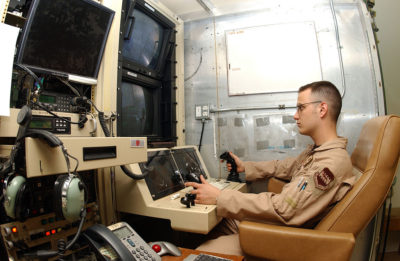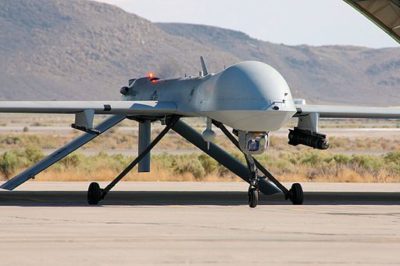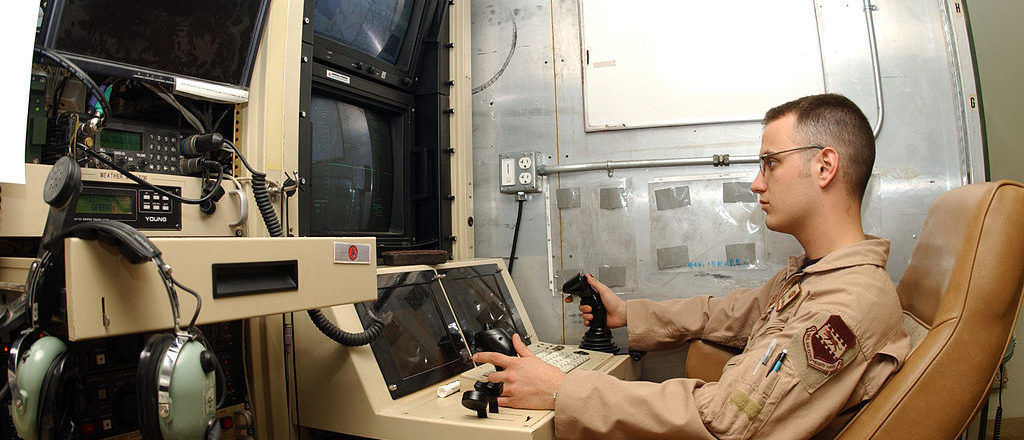A nation must think before it acts.

U.S. airman operating an unmanned aerial vehicle
Over the last decade, the spread of drone technology to militaries and violent non-state actors around the world has produced a dramatic change in the American perspective on warfare. Not too long ago, it would have been major news if the United States government killed anyone outside of a declared war zone. Today, in an era of anxiety and the constant Global War on Terror, we accept that the U.S. government will engage in targeted killings on a routine basis. While many people are uneasy with the remote nature of drone technology, the fundamental contours of targeted killing are widely accepted by the public and by Congress. Even in the bitter politics of the 2016 election, drones have been rarely discussed because Democrats and Republicans agree on their value and continued use.
In the arts, however, a number of voices have emerged to shine a harsh light on targeted killing and force us to confront questions about drones that we might otherwise leave unasked. The 2015 film Eye in the Sky, directed by Gavin Hood, has been perhaps the most effective in bringing the terrible moral dilemmas associated with this practice to a wider public. The film—a taut drama starring Helen Mirren as the world-weary British colonel Katherine Powell calling for a drone strike against an al-Shabaab target in Kenya—illustrates nicely how drone technology works and how political calculations, cowardice and bureaucratic infighting can sometimes dominate the decision-making process for these strikes.

Dame Helen Mirren at the premiere of Eye in the Sky at the Toronto International Film Festival (Source: flickr/ Peter Kudlacz)
The film provides a more or less accurate reflection of how targets are spotted, vetted and delivered for attack to operators thousands of miles away. In coordination with an array of intelligence analysts from the U.S. and UK governments, Colonel Powell tracks a series of targets, including a British citizen, to an al-Shabaab safe house in Kenya. Following their every move is U.S. Air Force Pilot Steve Watts, played by Aaron Paul, along with his copilot. This setup, mixing both U.S. and British military officers in an almost seamless command structure and requiring coordination over thousands of miles, from London to Creech Air Force Base in Nevada, is broadly similar to how the U.S. actually prosecutes its targeted killings today. Far from the stereotype of remote warfare, targeted killing by drones is remarkably intimate, with sometimes dozens of people viewing the target and weighing in on the decision to strike. As the film depicts, many of those people are lawyers and bring a constrained, careful approach to the use of force which is very different from how wars were conducted in the past. These people will also bring their own preferences, political calculations, and cowardice into decisions over life and death, as the film nicely illustrates with the performances by Alan Rickman and others.
The film also admirably avoids one of the most common stereotypes of drone warfare: that pilots believe that they are playing a video game and are morally removed from the consequences of their decisions. Aaron Paul’s excellent performance is closer to the truth. He shows Watts as morally conflicted, tired, and even saddened by the reality of what he has to do. There is no victory to be found in his operations, only anguish. When the mission is over and Watts stumbles out into the harsh glare of sunlight, he is incapable of engaging in the usual banter among comrades, and seems almost a man out of place and time. No one in the audience could think that Watts is anything but weighed down by the decision to launch a strike. This is one of the reasons why pilots that I have spoken to have encouraged me to see Eye in the Sky because in their view, it is more realistic than some of the critiques that they read about drones elsewhere.
At the same time, there are some dangers with taking Eye in the Sky as a realistic depiction of drone warfare. On one level, it puts too much stock in drone technology by suggesting that things which are not yet common are, in fact, routine when it comes to targeted killings. For example, the film depicts Kenyan Special Forces using an insect drone to fly inside a building and provide detailed audio and visual imagery of a number of terrorists meeting. While this technology does exist, it is more in the prototype stage and is not regularly used in this way, even by U.S. Special Forces. The hard reality is that those responsible for drone attacks must make decisions with far less information about the victims and their intent than this film implies. If anything, the use of the insect drone works in this film almost like wish fulfillment: we desperately wish to have this information to save us from uncertainty and morally costly mistakes, but have to live with a world in which it is not yet fully present. Equally, Eye in the Sky suggests that drone operators are able to calculate in advance the precise risks of civilian casualties based on the angle of the strike. This technology does exist, and calculations based on vector of the attack are made—sometimes with reasonable precision. However, the messy circumstances of real drone strikes mean that delays, uncertainty and confusion over civilian casualties prevail more than this film suggests.

MQ-1B Predator (Source: USGOV-PD)
The other problem with Eye in the Sky’s depiction of drone warfare is that it—perhaps inevitably—recasts the operation as a morality play. To provide the audience with a motive to invest in Colonel Powell’s dilemma, the film begins with the killing of an undercover British/Kenyan agent, showing just how ruthless the bad guys are and making us naturally sympathetic to the drone strike as a form of revenge. But the truth is that drone killings are rarely so tightly linked to a prior act of violence; in fact, they are more far deliberative and involve bureaucracies carefully building an almost-criminal case against the individual to permit their killing. Eye in the Sky also employs the trope of the ‘ticking time bomb’ pitting the U.S. and British officials contemplating a drone strike against a planned terrorist attack with clear civilian casualties. This allows the film to achieve dramatic momentum, but it is important to realize how rare these imminent attack scenarios are. Although the Obama administration has claimed drones are used to stop imminent threats, its definition of imminence is so flexible that it permits virtually anything. In real life, targeted killing is a choice, taken by our political leaders for strategic benefits, and it does not conform to the logic of emergency depicted here. By relying on a ticking time bomb scenario, the film lets the viewing public off the hook and does not challenge the audience to realize that its passive support has allowed the U.S. and a growing number of other governments to use targeted killing as a deliberate policy choice. It shows us the cost of that strike, but not the true costs of our own acquiescence.
Eye in the Sky is available for purchase on DVD & Blu-Ray on Amazon




